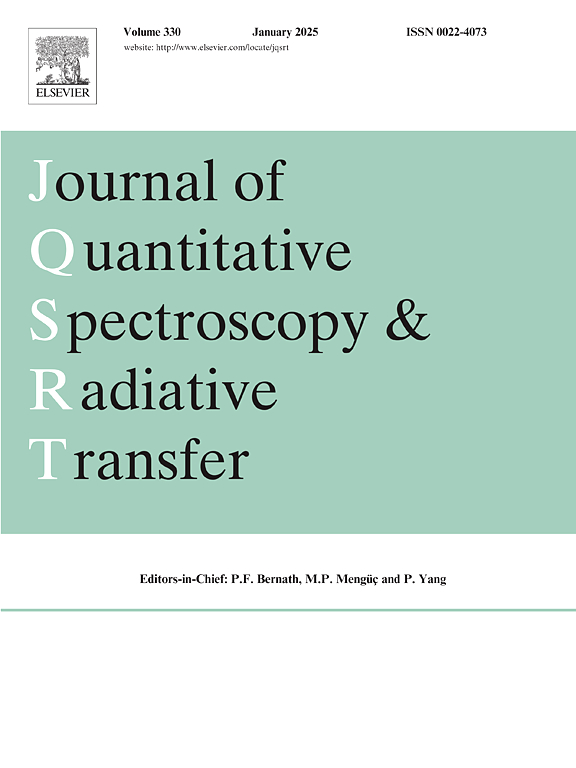Temperature dependence of the air-broadened line-shape parameters of the 1.27 µm O2-band
IF 2.3
3区 物理与天体物理
Q2 OPTICS
Journal of Quantitative Spectroscopy & Radiative Transfer
Pub Date : 2025-03-22
DOI:10.1016/j.jqsrt.2025.109448
引用次数: 0
Abstract
Satellite missions are considering the atmospheric O2 band at 1.27 µm to determine the air-column. A prerequisite of these demanding atmospheric applications is an accurate knowledge of the spectroscopy of this band, in particular of the line profiles and their temperature dependence. In the present work, fifty-five transitions of the 1.27 µm band of O2 have been studied with a cavity ring down spectrometer linked to an optical frequency comb referenced to a GPS-disciplined Rb oscillator. The comb-coherence transfer (CCT) technique was applied to obtain a RF tunable narrow-line comb-disciplined laser source from a set of distributed feedback laser diodes and a simple electro-optic modulator. High-quality spectra were obtained with a high-finesse cavity regulated at 253, 273 and 333 K. For each transition and each temperature, series of synthetic dry air spectra were recorded for five pressures, from 50 to 750 Torr. The line-shape parameters were retrieved thanks to a multi-spectrum fit procedure with a quadratic speed-dependent Nelkin-Ghatak profile and first-order line-mixing effect when required. For each transition, the temperature dependence exponents and coefficients of the different line profile parameters together with their values at the reference temperature of 296 K were determined. Absolute positions and intensities are provided by the fit with an average accuracy of 240 kHz (or 8 × 10–6 cm-1) and 0.2 %, respectively. An effect of intensity depletion with pressure on the order of 0.4 % atm-1 is evidenced. Comparison with literature, in particular with the HITRAN2020 database is discussed.
1.27µm o2波段空气展宽线形参数的温度依赖性
卫星任务正在考虑1.27µm的大气O2波段来确定气柱。这些苛刻的大气应用的先决条件是该波段光谱的准确知识,特别是谱线轮廓及其温度依赖性。在目前的工作中,用一个腔环下光谱仪连接到一个光学频率梳参考gps规范的Rb振荡器,研究了55个1.27µm波段的O2跃迁。采用梳相干传输(CCT)技术,从一组分布反馈激光二极管和一个简单的电光调制器中获得了射频可调谐的窄线梳规激光源。在253、273和333 K的高精细腔中获得了高质量的光谱。对于每个转变和每个温度,记录了从50到750 Torr的5种压力下的一系列合成干空气谱。利用二次速度相关的Nelkin-Ghatak剖面和一阶线混合效应的多谱拟合程序检索线形参数。在296 K的参考温度下,测定了不同谱线参数的温度依赖指数和系数。绝对位置和强度由拟合提供,平均精度分别为240 kHz(或8 × 10-6 cm-1)和0.2%。强度随压力衰减的影响约为0.4% atm-1。讨论了与文献的比较,特别是与HITRAN2020数据库的比较。
本文章由计算机程序翻译,如有差异,请以英文原文为准。
求助全文
约1分钟内获得全文
求助全文
来源期刊
CiteScore
5.30
自引率
21.70%
发文量
273
审稿时长
58 days
期刊介绍:
Papers with the following subject areas are suitable for publication in the Journal of Quantitative Spectroscopy and Radiative Transfer:
- Theoretical and experimental aspects of the spectra of atoms, molecules, ions, and plasmas.
- Spectral lineshape studies including models and computational algorithms.
- Atmospheric spectroscopy.
- Theoretical and experimental aspects of light scattering.
- Application of light scattering in particle characterization and remote sensing.
- Application of light scattering in biological sciences and medicine.
- Radiative transfer in absorbing, emitting, and scattering media.
- Radiative transfer in stochastic media.

 求助内容:
求助内容: 应助结果提醒方式:
应助结果提醒方式:


